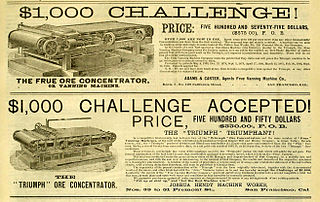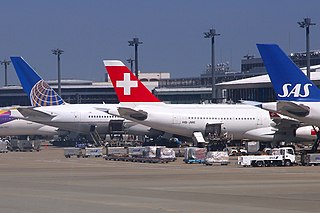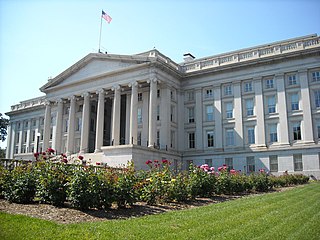Related Research Articles
An oligopoly (ολιγοπώλιο) is a market form wherein a market or industry is dominated by a small group of large sellers (oligopolists). Oligopolies can result from various forms of collusion that reduce market competition which then leads to higher prices for consumers and lower wages for the employees of oligopolies. Oligopolies have their own market structure.
In business theory, a disruptive innovation is an innovation that creates a new market and value network and eventually disrupts an existing market and value network, displacing established market-leading firms, products, and alliances. The term was defined and first analyzed by the American scholar Clayton M. Christensen and his collaborators beginning in 1995, and has been called the most influential business idea of the early 21st century. Lingfei Wu, Dashun Wang, and James A. Evans generalized this term to identify disruptive science and technological advances from more than 65 million papers, patents and software products that span the period 1954–2014. Their work was featured as the cover of the February 2019 issue of Nature and was selected as the Altmetric 100 most-discussed work in 2019.
In the field of management, strategic management involves the formulation and implementation of the major goals and initiatives taken by an organization's managers on behalf of stakeholders, based on consideration of resources and an assessment of the internal and external environments in which the organization operates. Strategic management provides overall direction to an enterprise and involves specifying the organization's objectives, developing policies and plans to achieve those objectives, and then allocating resources to implement the plans. Academics and practicing managers have developed numerous models and frameworks to assist in strategic decision-making in the context of complex environments and competitive dynamics. Strategic management is not static in nature; the models often include a feedback loop to monitor execution and to inform the next round of planning.

Porter's Five Forces Framework is a method for analysing competition of a business. It draws from industrial organization (IO) economics to derive five forces that determine the competitive intensity and, therefore, the attractiveness of an industry in terms of its profitability. An "unattractive" industry is one in which the effect of these five forces reduces overall profitability. The most unattractive industry would be one approaching "pure competition", in which available profits for all firms are driven to normal profit levels. The five-forces perspective is associated with its originator, Michael E. Porter of Harvard University. This framework was first published in Harvard Business Review in 1979.
Price skimming is a pricing strategy in which a marketer sets a relatively high initial price for a product or service at first, then lowers the price over time. It is a temporal version of price discrimination/yield management. It allows the firm to recover its sunk costs quickly before competition steps in and lowers the market price. It has become a relatively common practice for managers in new and growing market, introducing prices high and dropping them over time.
Price war is "commercial competition characterized by the repeated cutting of prices below those of competitors". One competitor will lower its price, then others will lower their prices to match. If one of them reduces their price again, a new round of reductions starts. In the short term, price wars are good for buyers, who can take advantage of lower prices. Often they are not good for the companies involved because the lower prices reduce profit margins and can threaten their survival.
Management consulting is the practice of helping organizations to improve their performance. Organizations may draw upon the services of management consultants for a number of reasons, including gaining external advice and access to consultants' specialized expertise.
McKinsey & Company is an American worldwide management consulting firm, founded in 1926 by University of Chicago professor James O. McKinsey, that advises on strategic management to corporations, governments, and other organizations. Under the leadership of Marvin Bower, McKinsey expanded into Europe during the 1940s and 1950s. In the 1960s, McKinsey's Fred Gluck—along with Boston Consulting Group's Bruce Henderson, Bill Bain at Bain & Company, and Harvard Business School's Michael Porter—transformed corporate culture. A 1975 publication by McKinsey's John L. Neuman introduced a scheme of "overhead value analysis" that contributed to a downsizing trend that eliminated many jobs in middle management.

The growth–share matrix is a chart that was created by Bruce D. Henderson for the Boston Consulting Group in 1970 to help corporations to analyze their business units, that is, their product lines. This helps the company allocate resources and is used as an analytical tool in brand marketing, product management, strategic management, and portfolio analysis. Some analysis of market performance by firms using its principles has called its usefulness into question.
A consulting firm or simply consultancy is a professional service firm that provides expert advice for a fee. Consulting firms may have one employee or thousands; they may consult in broad range of domains, for example, management, engineering, and so on.

Kearney is an American management consulting firm founded in 1926 as a branch of McKinsey & Company. The company became independent in 1939, and currently has offices in more than 40 countries worldwide. Kearney has consistently earned top places among global management consulting firm rankings, such as Vault's Consulting 50 and Consulting magazine's "Best Firms to Work For."

Ireland's Corporate Tax System is a central component of Ireland's economy. In 2016–17, foreign firms paid 80% of Irish corporate tax, employed 25% of the Irish labour force, and created 57% of Irish OECD non-farm value-add. As of 2017, 25 of the top 50 Irish firms were U.S.–controlled businesses, representing 70% of the revenue of the top 50 Irish firms. By 2018, Ireland had received the most U.S. § Corporate tax inversions in history, and Apple was over one–fifth of Irish GDP. Academics rank Ireland as the largest tax haven; larger than the Caribbean tax haven system.
In marketing strategy, first-mover advantage (FMA) is the competitive advantage gained by the initial ("first-moving") significant occupant of a market segment. First-mover advantage enables a company or firm to establish strong brand recognition, customer loyalty, and early purchase of resources before other competitors enter the market segment.

In economics, competition is a scenario where different economic firms are in contention to obtain goods that are limited by varying the elements of the marketing mix: price, product, promotion and place. In classical economic thought, competition causes commercial firms to develop new products, services and technologies, which would give consumers greater selection and better products. The greater the selection of a good is in the market, prices are typically lower for the products, compared to what the price would be if there was no competition (monopoly) or little competition (oligopoly). This is because there is now no rivalry between firms to obtain the product as there is enough for everyone. The level of competition that exists within the market is dependant on a variety of factors both on the firm/ seller side; the number of firms, barriers to entry, information availability, availability/ accessibility of resources. The number of buyers within the market also factors into competition with each buyer having a willingness to pay, influencing overall demand for the product in the market.
Oliver Wyman is an American management consulting firm. Founded in New York City in 1984, the firm has more than 60 offices in Europe, North America, the Middle East, and Asia-Pacific, employing over 5,000 professionals. It ranks among the best strategy consulting firms in the world in terms of prestige, growth, and employee satisfaction.

Market share is the percentage of a market accounted for by a specific entity.
Dynamic pricing, also referred to as surge pricing, demand pricing, or time-based pricing is a pricing strategy in which businesses set flexible prices for products or services based on current market demands. Businesses are able to change prices based on algorithms that take into account competitor pricing, supply and demand, and other external factors in the market. Dynamic pricing is a common practice in several industries such as hospitality, tourism, entertainment, retail, electricity, and public transport. Each industry takes a slightly different approach to dynamic pricing based on its individual needs and the demand for the product.
An economic profit is the difference between the revenue a business has received from its outputs and the opportunity costs of its inputs. An economic profit differs from an accounting profit as it considers both the firms implicit and explicit costs, where as an accounting profit only considers the explicit costs which appear on a firms financial statements. Due to the additional implicit costs being considered, the economic profit usually differs from the accounting profit.
Digital Transformation is the adoption of digital technology to transform services or businesses, through replacing non-digital or manual processes with digital processes or replacing older digital technology with newer digital technology. Digital solutions may enable – in addition to efficiency via automation – new types of innovation and creativity, rather than simply enhancing and supporting traditional methods.

Base erosion and profit shifting (BEPS) refers to corporate tax planning strategies used by multinationals to "shift" profits from higher-tax jurisdictions to lower-tax jurisdictions, thus "eroding" the "tax-base" of the higher-tax jurisdictions. The Organisation for Economic Co-operation and Development (OECD) define BEPS strategies as "exploiting gaps and mismatches in tax rules".
References
- 1 2 Viguerie, Patrick and Caroline Thompson. "The Faster They Fall". hbr.org. Harvard Business Review. Retrieved 20 September 2019.
- ↑ Anders, George (5 September 2007). "Countrywide Finds No. 1 Spot Isn't Easy". wsj.com. The Wall Street Journal. Retrieved 20 September 2019.
- ↑ Hagel, John. "Edge Perspectives". typepad.com. Retrieved 20 September 2019.
- ↑ Denning, Steve (12 January 2012). "Shift Index 2011: The Most Important Business Study – Ever?". Forbes. Retrieved 20 September 2019.
- ↑ Buescher, Brendan and Patrick Viguerie. "How US healthcare companies can thrive amid disruption". mckinsey.com. McKinsey & Company. Retrieved 20 September 2019.
| | This management-related article is a stub. You can help Wikipedia by expanding it. |